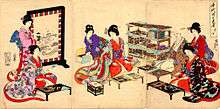Ōoku

The Ōoku (大奥 great interior) refers to the harem of Edo Castle, the section where the women connected to the reigning Shogun resided. Similar areas in the castles of powerful Daimyo, such as the Satsuma Domain, were also referred to by this term.[1]
History

The Ōoku was built inside the Honmaru enceinte of Edo Castle in 1607 by Tokugawa Hidetada,^ who passed a special law for the Ōoku which was completely separated from the outside world. Therefore, noblewomen living in the Ōoku could not leave the castle without permission, and that no women within the Ōoku can have a relationship with man. This system lasted for nearly 200 years.
Structure
There were no male adults admitted onto the floor of the Ōoku without the Shōgun. The corridor through which the Shōgun entered was called Osuzu Rōka (御鈴廊下, large corridor of the bells), derived from the ringing of the suzu bells to announce the entrance of the Shōgun. This corridor was the only route which connected the Ōoku to rest of Edo Castle, and it was usually locked.
There is Honmaru where Midaidokoro, shogun's official wife and her children resided (though only Oeyo, wife of Tokugawa Hidetada resided with her children). Ninomaru was shogun's concubines with their children resided and Sannomaru was Oomidaidokoro (the past shogun's official widow) and the past shogun's widow concubine who didn't have child also mother of the shogun resided in there. Nagatsubone was senior chamberlain and servants resided.
With the last fire that destroyed the Honmaru Palace of Edo Castle and the end of the Shogunate with the Meiji reforms, the Ōoku also ceased to exist.
Organisation
_MET_DP149382.jpg)

The womens quarters included the shōgun's mother, the official wife (seishitsu), and concubines. Rumored to house several thousand women, including maids and servants at one point, the Ōoku was, as much as any other part of Edo Castle, a focal point of political intrigue for the Tokugawa shogunate.
A lady in the rank of an Otoshiyori (御年寄) or Jōrō Otoshiyori (上臈御年寄) or the senior ladyship held the reins of power in the Ōoku, while attaining the influence equivalent to a Rōjū in Edo Castle.
Notable persons
- Kasuga no Tsubone, Shogun Tokugawa Iemitsu's wet nurse. She became the first Jōrō Otoshiyori in 1607, she was recommended by the first Midaidokoro, Oeyo. She managed Ooku with Oeyo from 1607 until Oeyo died in 1626, with Otama no Kata from 1640 until her death in 1643.
- Oman no Kata, she was the first concubine ever been named as Jōrō Otoshiyori later she acted as adopted mother of two Iemitsu's child; Chiyohime and the fourth shogun Tokugawa Ietsuna. she was concubine of Tokugawa Iemitsu and later she retired in march 1657.
- Lady Emonosuke, she was the second and last concubine that been named as Jōrō Otoshiyori from 1683 until her death in january 1705, she was concubine of Tokugawa Tsunayoshi.
- Lady Akimoto, she became Jōrō Otoshiyori in 1705 after the death of Lady Emonnosuke, she retired in 1709.
- Yajima no Tsubone, Shogun Tokugawa Ietsuna's wet nurse. She became the second Jōrō Otoshiyori in 1656 after Oman no Kata retired and later being banished from Ooku in 1675 after Ietsuna discovered that
- in 1675 she give a poison to Asa no Miya Akiko's powder, it makes Asa no Miya became blind (it makes her stressed and died a year later)
- in 1667 She give a poison to Ofuri no Kata's lipstick who at that time was pregnant, Ofuri had a miscarriage and soon died.
- Ejima, Jōrō Otoshiyori and the personal ladyship of Gekkoin, the mother of seventh shogun. Held the office from 1709 until 1714. She was expelled from Ōoku in 1714 because of a relationship with a man named Ikushima Shinggoro.
- Fujinami, Jōrō Otoshiyori and the personal ladyship of Ten'ei-in, widow of the sixth shogun. In office from 1714
- Ikushima the personal ladyship of Tenshoin. She retired from the Ōoku at 1859 and stayed with Muraoka, the senior ladyship of the Konoe family, until her death. She was buried at Satsuma.
- Niwata Tsuguko from Kyoto who was the personal ladyship of Princess Kazunomiya, Iemochi's wife. She died 1868 at the Ōoku.
- Takiyama (1805-1876), she was the last Jōrō Otoshiyori. She served the previous shogun, including Tokugawa Iesada and Atsuhime/Tenshouin, Tokugawa Iemochi and Kazunomiya or Seikan'in-no miya, and the last shogun Tokugawa Yoshinobu. After a new government took over Edo Castle, she moved to Kawaguchi, Saitama prefecture. Her remains were buried in Shakujo-ji Temple.
In popular culture
As no painting exists of the interior, ukiyo-e artists such as Hashimoto Chikanobu and Toyohara Chikanobu created a number of prints that depict life as imagined inside.
There were many popular portrayals of the Ōoku.[2]
- Ōoku: Hana no Ran (Japanese television drama)
- Ōoku (1983 television drama, starring Tomisaburō Wakayama, Tetsuro Tamba, Masaya Oki, Shigeru Tsuyuguchi)
- Atsuhime (NHK Taiga drama)
- Oh! Oku (2006 film)
- Ōoku: The Inner Chambers (Japanese manga)
- Masami Okui best album: Ōoku (2008)
- Ōoku (2010 film)
Notes
^ The name and title of "Ooku" was given by Oeyo, Tokugawa Hidetada's wife
^ Her name before Iemitsu become the third shogun
^ her name after Iemitsu become the third shogun
References
- ↑ "Archived copy". Archived from the original on 2008-10-19. Retrieved 2008-10-09.
- ↑ ja:大奥に関する作品の一覧
External links
![]() Media related to Ōoku at Wikimedia Commons
Media related to Ōoku at Wikimedia Commons
 The dictionary definition of ōoku at Wiktionary
The dictionary definition of ōoku at Wiktionary
Coordinates: 35°41′18″N 139°45′16″E / 35.688324°N 139.754389°E